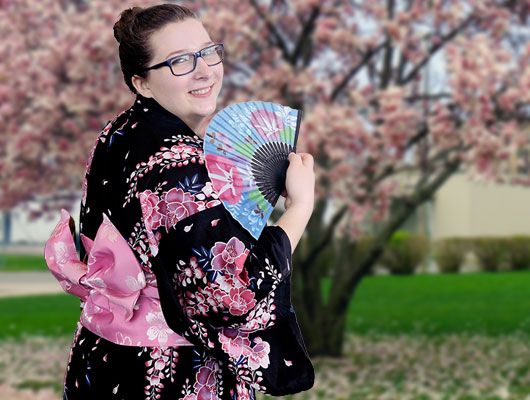 Pictured | Allison Steele | English / Minors in Psychology and East Asian Studies | Edwardsburg, Michigan (hometown)
Pictured | Allison Steele | English / Minors in Psychology and East Asian Studies | Edwardsburg, Michigan (hometown)
Allison is pictured wearing her yukata, worn at summer festivals in Japan.
Japanese and Chinese | EALC
P Prerequisite | C Co-requisite | R Recommended
I Fall Semester | II Spring Semester | S Summer Session/s
Note | All world language classes may require homework using audio-, visual-, or computer-based materials in the World Languages Resource Center.
- EALC-C 101 Elementary Chinese 1 (2-4 cr.) An introductory course that lays groundwork for the study of modern Chinese. It aims at fostering proficiency in all four language skills (aural understanding, speaking, reading, and writing), and helping students handle simple tasks in daily routines. Basic sentence patterns, vocabulary, and characters are all practiced in meaningful contexts.
- EALC-C 201 Second Year Chinese 1 (2-4 cr.) P: EALC-C 102 or equivalent. Building on the grammar and lexicon from first-year, students will explore the broader cultural context in which language is used, experience more subtle oral and written forms, and learn to use perspectives in addition to the speaker's.
- EALC-E 271 Modern and Contemporary Japanese Culture (3 cr.) Examination of a range of Japanese culture expressions of the twentieth and twenty-first centuries, such as literature, theater, film, popular culture, and their historical contexts.
- EALC-E 350 Studies in East Asian Society (3 cr.) Selected issues and problems of importance to the understanding of East Asian society.
- EALC-J 101 Elementary Japanese 1 (2-4 cr.) An introductory skills-oriented course emphasizing learning language in context, development of listening and speaking in simple interactional situtions, and controlled reading and writing skills.
- EALC-J 102 Elementary Japanese 2 (2-4 cr.) P: EALC-J 101 with a C or higher, placement, or instructor's permission. An introductory, skills-oriented course that emphasizes a pragmatic, contextual approach to learning grammar and vocabulary. The goal of this course is interactional competence in a limited variety of communicative situations. Students will also learn to read and write whatever they can say. Kana syllabaries and some kanji introduced.
- EALC-J 201 Second Year Japanese 1 (2-4 cr.) P: EALC-J 201 with a C or higher, placement, or instructor's permission. Continuation of emphasis on communicative skills. Increased attention to reading and writing skills. I
- EALC-J 202 Second Year Japanese 2 (2-4 cr.) P: EALC-J 201 with a C or higher, placement, or instructor's permission. Continuation of EALC-J 201. II
- EALC-J 301 Third Year Japanese 1 (3-4 cr.) P: EALC-J 202 with a C or higher, placement, or instructor's permission. Review of grammatical points acquired in the first and second year Japanese. More advanced level of speaking, reading, writing, and listening proficiency.. I
- EALC-J 302 Third Year Japanese 2 (3-4 cr.) P: EALC-J 301 with a C or higher, placement, or instructor's permission. Review of grammatical points acquired in the first and second year of Japanese. More advanced levels of speaking, reading, writing and listening proficiency. II
- EALC-J 310 Japanese Conversation (3 cr.) P: EALC-J 302 with a C or higher, placement, or instructor's permission. This course is designed to develop conversational skills as well as overall proficiency in Japanese. Through controlled conversation with an emphasis on the vocabulary building and usage, the use of linguistic devices, group activities and classroom discussion, students will develop conversational skills.
- EALC-J 401 Fourth-Year Japanese I (3 cr.) P: EALC-J 302 with a C or higher, placement, or instructor's permission. Emphasis on advanced reading skills. I
- EALC-J 402 Fourth-Year Japanese II (3 cr.) P: EALC-J 401 with a C or higher, placement, or instructor's permission. Continuation of J401. To develop advanced skills in Japanese for speaking, reading, and writing.
- EALC-J 451 Readings in Japanese Newspapers and Journals (3 cr.) P: EALC-J 302 with a C or higher, placement, or instructor's permission. Exploration of the salient features of the academic and journalistic writing style of modern expository Japanese used by prominent thinkers, well-known journalists, and critical essayists of Japan today.